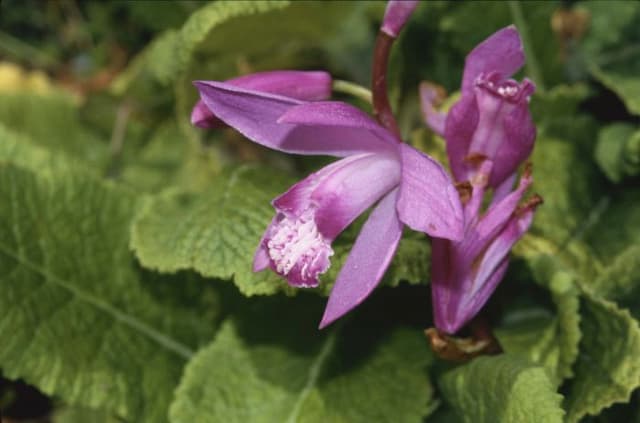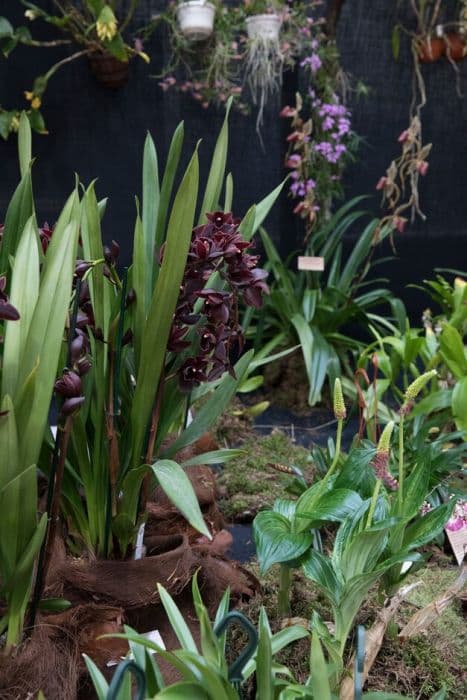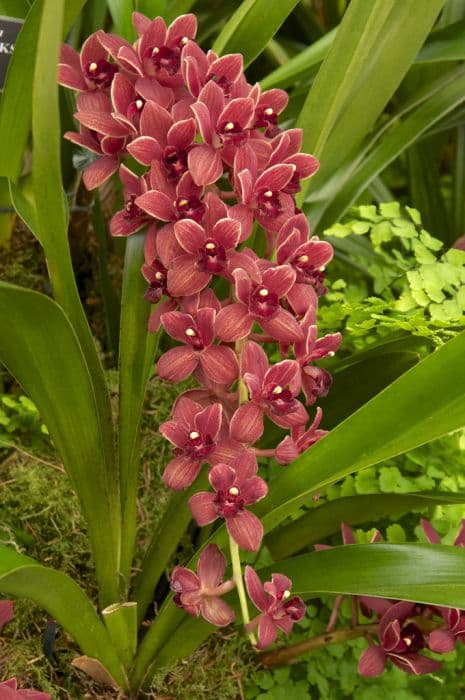Low's Cymbidium Cymbidium lowianum

ABOUT
Cymbidium lowianum, commonly known as Low's cymbidium, is a perennial plant with a striking and elegant appearance. This orchid features a robust and fleshy root system, which often anchors itself to the substrate where it grows. The plant displays long, narrow, strap-shaped leaves that cascade downward and can be a deep, glossy green color. These leaves form a lush backdrop for the plant's most remarkable feature, its blooms. The flowers of Low's cymbidium emerge on arching or pendulous flower spikes, which produce multiple blossoms when in season. Each bloom is intricately detailed and sizable, featuring a pleasing symmetry. The petals and sepals can vary in color from greenish-yellow to brownish-green, often with contrasting patterns or spots that add to their allure. The central part of the flower consists of a lip or labellum, which is usually quite showy and can feature different colors or patterns compared to the rest of the blossom. It is designed to attract pollinators and is therefore the most elaborate and vibrant part of the flower. In perfect flowering conditions, Low's cymbidium can produce a breathtaking display, with each flower spike hosting numerous individual blossoms that contribute to a splendid floral showpiece. This striking appearance, combined with its luscious foliage, makes it a cherished plant among orchid enthusiasts and a popular choice for ornamental displays in gardens or as potted houseplants.
About this plant
 Names
NamesFamily
Orchidaceae
Synonyms
Low's Cymbidium, Low's Orchid
Common names
Cyperorchis lowiana, Cymbidium lowianum var. kalawense.
 Toxicity
ToxicityTo humans
The Cymbidium lowianum, commonly known as boat orchid, is not known to be toxic to humans. There are no reports of poisoning or adverse effects from ingesting or handling this plant, and it is generally considered safe around humans.
To pets
The boat orchid, or Cymbidium lowianum, is also not toxic to pets. It is not known to cause any symptoms of poisoning in animals such as cats and dogs, and they can safely coexist with this plant in their environment.
 Characteristics
CharacteristicsLife cycle
Perennials
Foliage type
Evergreen
Color of leaves
Green
Flower color
Varies
Height
2 feet (60 cm)
Spread
2 feet (60 cm)
Plant type
Orchid
Hardiness zones
10
Native area
Southeast Asia
Benefits
 General Benefits
General Benefits- Aesthetic Appeal: Cymbidium lowianum, commonly known as the Low's Cymbidium, features showy and exotic blooms that enhance the visual appeal of any space.
- Horticultural Interest: It is prized by orchid enthusiasts for its large, beautiful flowers and ease of cultivation in comparison to other orchids.
- Long Bloom Period: The Low's Cymbidium typically has a prolonged flowering season, providing a display of blooms for an extended amount of time.
- Versatility in Landscaping: Can be used in a variety of garden settings, from potted arrangements to orchid displays in greenhouses.
- Symbolic Significance: In certain cultures, the Low's Cymbidium may symbolize virtue and morality, making it a meaningful gift or ornamental plant.
- Tolerant of a Range of Climates: This species is relatively hardy and can tolerate cooler temperatures better than many other tropical orchids.
 Medical Properties
Medical PropertiesThis plant is not used for medical purposes.
 Air-purifying Qualities
Air-purifying QualitiesThis plant is not specifically known for air purifying qualities.
 Other Uses
Other Uses- Cymbidium lowianum, commonly known as Low's cymbidium, can be used as a natural dye for fabrics, providing a range of colors from soft yellows to greens depending on the mordant used.
- Floral arrangements often feature Low's cymbidium as a long-lasting cut flower due to its sturdy stems and vibrant blooms.
- The pseudobulbs of Low's cymbidium are sometimes incorporated into handmade jewelry or decor, especially within its native regions, as a symbol of natural beauty.
- In certain cultures, the blooms of the Low's cymbidium might be used in culinary presentations as edible decor, although they are not typically consumed.
- The strong fibers present in the leaves have been traditionally used for weaving small baskets or crafts in regions where the plant is indigenous.
- Low's cymbidium can be cultivated as a companion plant in gardens to create microclimates that provide shade or protection for more delicate plants.
- This plant has been used in teaching botany and horticulture, as it represents an interesting case study for orchid care and propagation techniques.
- In some artisan communities, pressed or dried flowers of the Low's cymbidium are used in the creation of natural potpourris.
- Low's cymbidium is occasionally used in perfumery for its subtle fragrance, although it is not one of the primary sources for aroma extraction.
- Its impressive presence is also exploited in photography and plant-based art installations, where the orchid adds an exotic and luxurious element.
Interesting Facts
 Feng Shui
Feng ShuiThe Cymbidium orchid is believed to bring good fortune and prosperity in Feng Shui, often used to enhance the positive energy in areas associated with wealth and relationships.
 Zodiac Sign Compitability
Zodiac Sign CompitabilityThe Cymbidium orchid is not used in astrology practice.
 Plant Symbolism
Plant Symbolism- Beauty and Refinement: The Cymbidium orchid, with its elegant flowers and graceful form, is often associated with beauty and sophistication. It is commonly presented as a gift to convey admiration for someone's refined qualities.
- Love and Affection: Due to their captivating appearance and long-lasting blooms, Cymbidium orchids are symbolic of love and affection. They are a popular choice for romantic occasions like anniversaries or Valentine's Day.
- Good Fortune: In many cultures, Cymbidium orchids are considered to bring good luck and fortune. They are often displayed during the New Year or at celebrations to encourage a prosperous future.
- Virtue and Morality: The Cymbidium orchid carries a connotation of virtue and morality, making it an emblem of those who uphold strong ethical principles and values.
- Fertility and Abundance: In some traditions, Cymbidium orchids represent fertility and abundance due to their vigorous growth and the numerous flowers they produce.
 Water
WaterThe Boat Orchid should be watered once a week during active growth using lukewarm water, ensuring that the potting medium is moist but not soggy. During the rest period, after the blooms have faded, reduce watering to every other week. When watering, provide about one quart to a mature plant, ensuring thorough saturation of the potting medium. Ensure excess water is allowed to drain away to prevent root rot. During hot or windy weather, increase the frequency of watering to maintain consistent moisture.
 Light
LightBoat Orchids thrive in bright, indirect light so placing them in a location where they receive morning light or filtered afternoon light is ideal. Direct sunlight should be avoided as it can burn the leaves. A spot near an east or west-facing window with some shading is best to provide the light conditions the Boat Orchid requires for optimal growth.
 Temperature
TemperatureBoat Orchids prefer a moderate temperature range with daytime highs around 70-80 degrees Fahrenheit and nighttime lows not dropping below 50 degrees Fahrenheit. They can tolerate temperatures up to 95 degrees Fahrenheit but should be protected from frost. An ideal temperature range for encouraging blooming is cooler nights around 50-60 degrees Fahrenheit and warmer days.
 Pruning
PruningPrune Boat Orchids to remove dead or diseased leaves and spent flower stalks to encourage healthy growth and reblooming. Pruning is best done after flowering, typically in the late winter or early spring. Using sterilized cutting tools, cut the flower spikes close to the base but be careful not to damage new growths. Pruning can be done annually or as needed when the plant appears overcrowded.
 Cleaning
CleaningAs needed
 Soil
SoilThe best soil mix for Cymbidium orchids, commonly known as Boat Orchid, should be well-draining and provide adequate aeration to the roots. A common recipe includes fir bark or pine bark with perlite and peat moss in equal parts. The preferred soil pH for Cymbidium orchids is slightly acidic to neutral, ranging from 5.5 to 7.0.
 Repotting
RepottingBoat Orchids should be repotted every two to three years or when the potting medium starts to decompose. Repotting is best done after the flowering season in the spring, giving the plant time to establish before the next blooming cycle.
 Humidity & Misting
Humidity & MistingBoat Orchids thrive in moderate to high humidity levels, generally between 40% to 70%. Maintaining these humidity conditions will support healthy growth and blooming.
 Suitable locations
Suitable locationsIndoor
Place in bright, indirect light with cool temps and good air flow.
Outdoor
Provide dappled shade, protect from frost, and ensure good air circulation.
Hardiness zone
9-12 USDA
 Life cycle
Life cycleCymbidium lowianum, commonly known as Low's Cymbidium, begins its life cycle as a seed, requiring symbiosis with a mycorrhizal fungus to germinate and develop into a protocorm, which is an intermediate stage between seed and seedling. The protocorm develops into a seedling, which gradually forms leaves and roots as it matures. Over several years, the seedling grows into a vegetative adult plant with long, strap-like leaves and a robust root system. The adult plant eventually reaches reproductive maturity and produces inflorescences, which bear multiple flowers, commonly from late winter to early spring. After pollination and fertilization, the flowers develop into fruit capsules containing numerous tiny seeds, which are then dispersed, completing the life cycle. The adult Cymbidium lowianum plant can survive for many years, producing new flowers seasonally, often requiring a cool, dry period to initiate blooming.
 Propogation
PropogationPropogation time
Spring-Early Summer
Propogation: The Cymbidium lowianum, commonly known as the Boat Orchid, is typically propagated through division, which is best done when the plant has outgrown its pot or when there are at least six pseudobulbs in the cluster. The most popular method involves carefully separating the pseudobulbs with a sterilized knife or garden shears, making sure that each division has at least three pseudobulbs to ensure a successful growth. After dividing, the cut surfaces should be treated with a fungicide to prevent infection. The divisions can then be potted in fresh orchid potting mix. It is essential to maintain high humidity and provide adequate water without overwatering during the initial few weeks after repotting to help the divisions establish their root systems. This process is ideally done in the spring, after the flowering period when the plant is entering its active growth phase.









